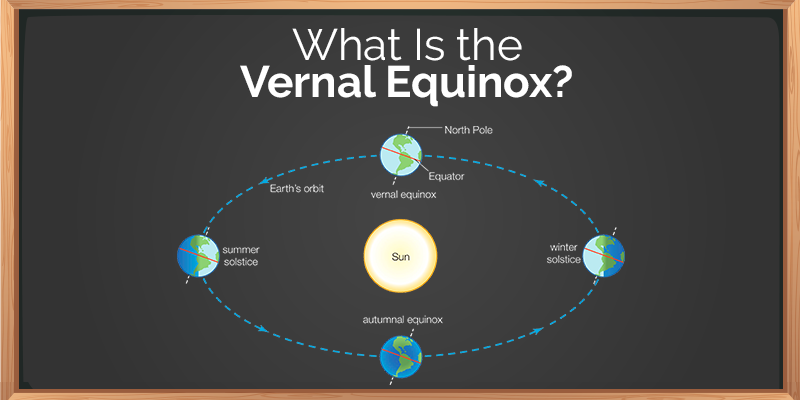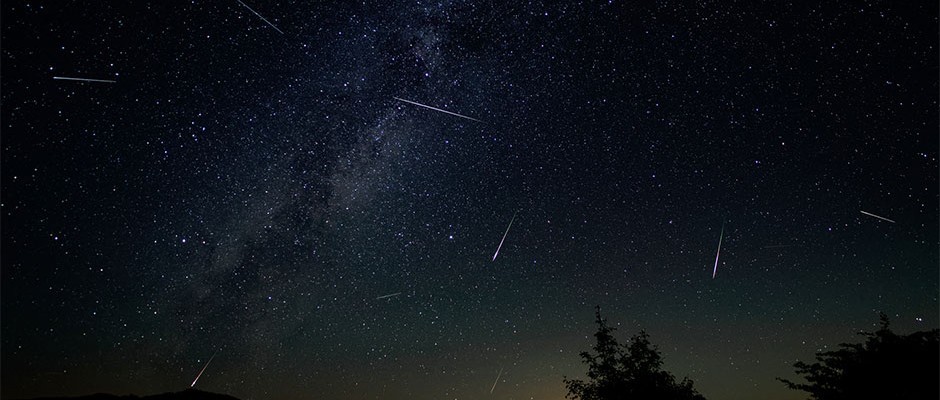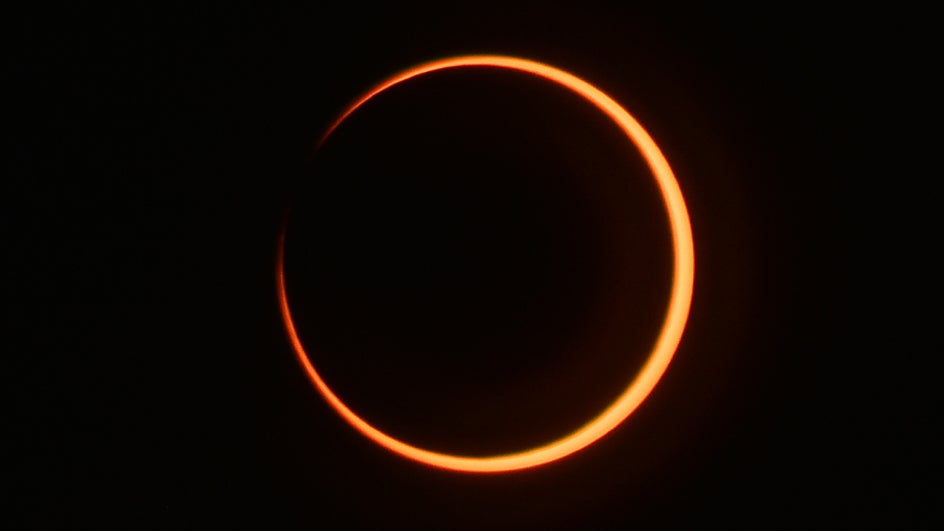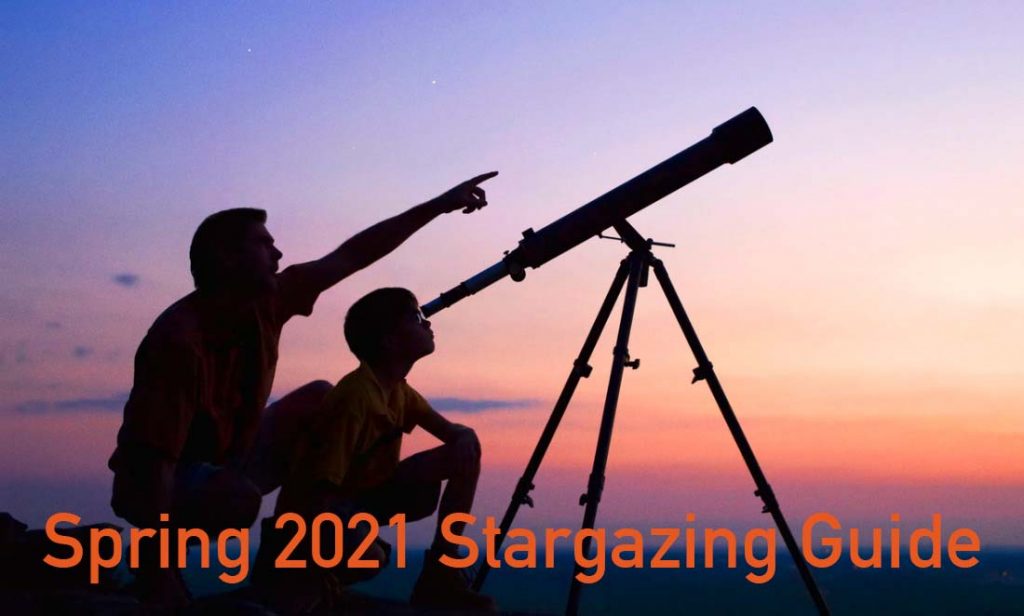Welcome to the first in our four part series detailing the major events of 2021’s astronomical calendar. This guide will help you to set your stargazing itinerary, providing a detailed listing of what each month’s sky has to offer. We will begin in March of 2021, when astronomical spring is ushered in with the Vernal Equinox on March 20th, and follow the celestial rotation for the remainder of the astronomical year, which will take us into 2022.
This guide aims to provide you with precise dates that allow for easiest viewings of celestial objects from the vantage of North America, including the stages of the Moon, the planets, meteor showers, and the best times to view a number of highly sought after deep sky objects. For further details to help in locating these objects with their specific longitudes, there are a number of star-finder resources online that we suggest you view in preparation for viewing. Get your personal calendar ready so that you can plan out your amateur astronomy schedule for spring.
MARCH
The Vernal Equinox
On March 20th, astronomical spring will begin with the Vernal Equinox, named so because the path of the sun rests on the equator, providing for an equal division between daylight and nighttime hours. From here, the Northern Hemisphere will begin to tilt toward the Sun, providing for longer days and shorter nights.

The Moon: Worm Moon
On March 21st, the Moon will be at First Quarter, which is when the Lunar Terminator, or the line of shadow that divides the Moon’s surface, will be at its halfway point, illuminating the right side of the Moon. This is the best time to observe the moon, as the shadows cast by the Lunar Terminator provide for some great contrast of the lunar surface. March 28th, the Full Moon will appear, known at this time of the year as the Worm Moon. This is due to the seasonal change, with spring ushering earthworms above ground as the temperatures begin to rise. This month’s Worm Moon will also occur as what’s known as a Supermoon, when the Moon’s Full Moon phase occurs at the same time as the closest point in its orbit around Earth. The Supermoon is when the Moon will seem its largest and brightest in the night sky, appearing 7% larger than average. 2021 is unique, as it will feature four Supermoons in a row, this one being the first.
Makemake
Partially responsible for Pluto losing its status as a planet, the dwarf planet Makemake will reach its opposition on March 27th. This also coincides with its perigee, or the closest point in relation to the Earth, making this the easiest date in which to view the dwarf planet thanks to its heightened brightness and size. Still, the dwarf planet will appear as a relatively small point of light, located within the constellation Coma Berenices.
Venus
Venus will appear at its greatest brightness on March 28th. Venus will be so bright that it will be the third brightest object in the sky, after the sun and the moon, and this marks the perfect time to both observe and photograph the planet. Take advantage of this opportunity, because Venus will not appear at this brightness for another 1.6 years.
APRIL
The Moon: Pink Moon
The Moon will appear in Last Quarter on April 4th, when the lunar terminator reveals the best time to view and photograph the left half of the visible Moon. April 12th sees the birth of the New Moon, when the cycle of the Moon’s phases begins anew. This is the best time to view and photograph the night sky, as the Moon’s illumination is at its lowest, granting the clearest views of the spiraling arms of the Milky Way. On April 20th, the Moon will be at First Quarter, revealing the right half of the visible Moon. The Full Moon on April 27th will appear as what’s known as a Supermoon, when the Moon’s Full Moon phase occurs at the same time as the closest point in its orbit around Earth. The Supermoon is when the Moon will seem its largest and brightest in the night sky, appearing 7% larger than average. 2021 is unique, as it will feature four Supermoons in a row, this one being the second. This particular Supermoon is also known as the Pink Moon, named after a type of flower called the Wild Ground Phlox, native to North America and which blooms in a moss like covering this time every year.
Earthshine
Although Earthshine is a phenomena that occurs every month of the year around the time of a New Moon, it is most prominent in the months of April and May. Earthshine is when the Moon is so close to Earth that light is reflected from the surface of our planet back onto the Moon, slightly illuminated the shadowed portion of the lunar surface. The best days to see Earthshine this month are April 8th and April 15th.
M104
Also known as the Sombrero Galaxy, M104 will reach its highest point in the horizon on April 2nd, making it one of the easiest times to locate it. It is named for the thick ring of dust that surrounds its bright and enlarged nucleus. This Messier Object can be located between the constellations of Virgo and Corvus, and is an elliptical galaxy roughly 30% the size of our own Milky Way.
M94
A two-ringed spiral galaxy, M94 is a Messier Object that will reach its highest point on the horizon on April 5th. Also known as the Cat’s Eye Galaxy, it can be located in the constellation of Canes Venatici, and is one of the brightest galaxies in the M94 group of galaxies.
Asteroid 9 Metis
Asteroid 9 Metis will reach opposition on April 5th, reaching its highest point on the horizon in the constellation Virgo. Considered a minor planet, it is one of the largest of the main-belt asteroids, members of the asteroid belt that lies between the orbits of Jupiter and Mars.
Saturn
Saturn will come into conjunction with the Moon on April 6th, both objects appearing within the constellation of Capricornus.
Jupiter
Jupiter will come into conjunction with the Moon on April 7th, both objects appearing within the constellation of Capricornus.
M51
Also known as the Whirlpool Galaxy, M51 will reach its highest point in the horizon on April 15th. M51 can be located in the constellation of Canes Venatici. M51 is actually an interacting grand-design spiral galaxy made up of M51a and M51b, the former and larger of the two galaxies reaching out to the other with a dust-rich tidal bridge.
M83
Also known as the Southern Pinwheel Galaxy, M83 will reach its highest point in the horizon on April 17th. This barred spiral galaxy lies between the constellations of Hydra and Centaurus. Unfortunately, it can only be seen by the southern portions of North America, and is completely invisible to any areas resting above latitude 40˚N.
Haumea
Named after the Hawaiian goddess of childbirth, Haumea is a dwarf planet that lies past Neptune’s orbit. It will reach opposition on April 17th, also coinciding with its perigee, and can be found just south of the constellation of Bootes. Haumea is the third largest trans-Neptunian object, after dwarf planets Pluto and Eris.
Mars
Mars will come into conjunction with the Moon on April 17th, both objects appearing within the constellation of Taurus.
M3
The first Messier Object to be found by Charles Messier, M3 is a globular cluster made up of over 500,000 stars. It will reach its highest point in the horizon on April 18th, and can be found between the constellations of Bootes and Canes Venatici. M3 contains more variable stars than any other star cluster.
Lyrid Meteor Shower
Occurring between the dates of April 16th to April 25th, and peaking on April 22nd, the Lyrid Meteor Shower has been observed and recorded longer than any other meteor shower, and was first reported in 687 BCE. Created by the shed of Comet Thatcher, the Lyrid Meteor Shower radiates from the constellation Lyra and travel through to the constellation Hercules.
M101
Also known as the Pinwheel Galaxy, M101 will reach its highest point in the horizon on April 23rd. One of the final entries into the Messier Catalogue, and nearly twice the size and with double the amount of stars as the Milky Way, the Pinwheel Galaxy can be located within the constellations of Ursa Major and Bootes.
Pi Puppid Meteor Shower
Occurring between the dates of April 15th to April 28th, and peaking on April 23rd, the Pi Puppid Meteor Shower is only observable every five years. Created by the shed of Comet Grigg–Skjellerup, the Pi Puppid Meteor Shower radiates from the center of the constellation Puppid. Unfortunately, the Pi Puppid Meteor Showers have lightened since their discovery in 1997, as Jupiter has disturbed the trail that Comet Grigg–Skjellerup leaves in its wake, and it is speculated that the showers might soon disappear altogether.
MAY
The Moon: Flower Moon
On May 3rd, the Moon will appear at its Last Quarter, when the lunar terminator reveals the best time to view and photograph the left half of the visible Moon. May 11th sees the birth of the New Moon, when the cycle of the Moon’s phases begins anew. This is the best time to view and photograph the night sky, as the Moon’s illumination is at its lowest, granting the clearest views of the spiraling arms of the Milky Way. On May 19th, the Moon will be at First Quarter, revealing the right half of the visible Moon. The Full Moon on May 26th will appear as what’s known as a Supermoon, when the Moon’s Full Moon phase occurs at the same time as the closest point in its orbit around Earth. The Supermoon is when the Moon will seem its largest and brightest in the night sky, appearing 7% larger than average. 2021 is unique, as it will feature four Supermoons in a row, this one being the third, and the brightest. This particular Supermoon is also known as the Flower Moon, named after the seasonal bloom of wildflowers that occurs across the Northern Hemisphere at this time. The Moon will also undergo a Total Lunar Eclipse on May 26th, which will be visible across the Western parts of North America.
Earthshine
Although Earthshine is a phenomena that occurs every month of the year around the time of a New Moon, it is most prominent in the months of April and May. Earthshine is when the Moon is so close to Earth that light is reflected from the surface of our planet back onto the Moon, slightly illuminated the shadowed portion of the lunar surface. The best days to see Earthshine this month are May 7th and May 14th.
Saturn
Saturn will come into conjunction with the Moon on May 3rd, both objects appearing within the constellation of Capricornus. Saturn will come into a second lunar conjunction in Capricornus on May 30th.
Jupiter
Jupiter will come into conjunction with the Moon on May 4th, both objects appearing within the constellation of Aquarius.
Eta Aquariid Meteor Shower
Occurring between the dates of April 19th to May 28th, and peaking during the entire week surrounding May 6th, the Eta Aquariid Meteor Shower is one of the longest of the annually occurring meteor showers. Created by the shed of the infamous Haley’s Comet, the Eta Aquariid Meteor Shower radiates from the constellation Aquarius. In the Northern Hemisphere, it is best seen just before dawn. The meteors seen during the Eta Aquariid Meteor Shower are not indicative of the arrival of Halley’s Comet, as they were shed from the comet hundreds of years prior to its current orbit, which only brings it near Earth every seventy-five years.

Eta Lyrid Meteor Shower
Occurring between the dates of May 3rd to May 14th, and peaking on May 8th, the Eta Lyrid Meteor Shower radiates out of the constellation Lyra. Created by the shed of Comet IRAS–Araki–Alcock, which in 1983 made the closest approach to Earth than any comet in two centuries, the Eta Lyrid Meteor Shower is typified by its brighter than average meteors.
M5
One of the largest globular clusters known to man, M5 was first formed an astounding 13 Billion years ago, making it nearly as old as the universe itself. Estimated to have somewhere between 100,000 and 500,000 stars, including a dwarf nova, M5 will reach its highest point on the horizon on May 12th and can be found in the constellation of Serpens.
Mercury
Mercury will reach its highest point above the horizon on May 15th. This makes it the best time to observe and photograph the first planet from the Sun. It also falls just after Mercury reaches dichotomy, where it will be lit similar to the way the Moon is during its Quarter Phases, on May 12th, and just before its point of greatest eastern elongation from the Sun on May 17th.
Mars
Mars will come into conjunction with the Moon on May 16th, both objects appearing within the constellation of Gemini.
Total Lunar Eclipse
Along with the Flower Supermoon, May 26th will feature a Total Lunar Eclipse. This sees the Earth come between the Sun and Moon, and Earth’s shadow cast a shadow over the lunar surface, completely covering the Moon at the peak of the eclipse. This produces a reddish-brown glow as light from the Sun bends around the Earth. The Total Lunar Eclipse will be visible across North America, but will be most easily viewed on the western portion of the continent.
M4
The first globular cluster in which individual stars were identified, M4 peaks in height on the horizon on May 29th. M4 is one of the easiest star clusters to find, being about the size of the Moon, and located in the constellation of Scorpius, just to the right of the star Antares.
JUNE
The Moon: Strawberry Moon
On June 2nd, the Moon will appear at its Last Quarter, when the lunar terminator reveals the best time to view and photograph the left half of the visible Moon. June 10th sees the birth of the New Moon, when the cycle of the Moon’s phases begins anew. This is the best time to view and photograph the night sky, as the Moon’s illumination is at its lowest, granting the clearest views of the spiraling arms of the Milky Way. On June 18th, the Moon will be at First Quarter, revealing the right half of the visible Moon. The Full Moon on June 24th will appear as what’s known as a Supermoon, when the Moon’s Full Moon phase occurs at the same time as the closest point in its orbit around Earth. The Supermoon is when the Moon will seem its largest and brightest in the night sky, appearing 7% larger than average. 2021 is unique, as it will feature four Supermoons in a row, this being the last. This particular Supermoon is also known as the Strawberry Moon, as it notified the Algonquin tribes that wild strawberries we ripened and ready to gather.
Jupiter
Jupiter will come into conjunction with the Moon on June 1st, both objects appearing within the constellation of Aquarius.
M13
Also known as the Hercules Globular Cluster, M13 peaks in height on the horizon on June 3rd. The stars that make up M13, which is located in the constellation Hercules, number in the hundreds of thousands, and are so dense that they will form “blue stragglers”—new stars formed by the collision of established stars.
M12
M12 is a globular cluster that peaks in height on the horizon on June 4th. Located in the constellation of Ophiuchus, M12 has been found to have an unusually small number of low-mass stars, which are presumed to have been swallowed by our own Milky Way Galaxy.
Asteroid 63 Ausonia
Asteroid 63 Ausonia will reach opposition on June 4th, reaching its highest point on the horizon in the constellation Scorpius. Unfortunately, it will only be visible in the southernmost parts of North America. 63 Ausonia is a member of the Vesta Family of Asteroids, which are thought to have broken off of the minor planet 4 Vesta, which is the second largest object in the Asteroid Belt.
M10
M10 is a globular cluster that peaks in height on the horizon on June 6th. Located in the constellation of Ophiuchus, M12 has been found to be enriched with elements formed in Type II Supernovae.
M62
M62 is a globular cluster that peaks in height on the horizon on June 7th. It is located between the constellations of Ophiuchus and Scorpius. Unfortunately, it will only be visible in the southernmost parts of North America. M62 is one of the ten most massive globular clusters on record.
Annular Solar Eclipse
Brandishing a ring with an intense appearance of orange fire, an Annular Solar Eclipse occurs when the Moon passes directly in front on the Sun. Occurring on June 10th, it will only be visible to most of the eastern portions of North America as partial solar eclipse, but areas of northeast Canada will be able to view the Annulation.

The Daytime Arietids Meteor Shower
Occurring between the dates of April 14th to June 24th, and peaking on June 10th, the Daytime Arietids Meteor Shower radiates out of the constellation Aries, and is one of the brightest daytime Meteor Showers. Although the origination of the Arietids is unknown, it is speculated that they were shed by either the asteroid 1566 Icarus or the comet 96P/Machholz.
M92
M92 is a globular cluster that peaks in height on the horizon on June 12th. Located in the constellation of Hercules, and is one of the brighter globular clusters in the northern hemisphere.
Mars
Mars will come into conjunction with the Moon on June 13th, both objects appearing within the constellation of Cancer.
M6
Also known as the Butterfly Cluster, M6 is an open star cluster that will peak in the horizon on June 17th. Located between the constellations of Sagittarius and Scorpio, M6 was officially discovered in 1654 although there is argument that is was also observed by Ptolemy in the first century. Unfortunately, it will only be visible in the southernmost parts of North America.
IC4665
IC4665 is an open star cluster that peaks in height on the horizon on June 19th. Located in the constellation of Ophiuchus, IC4665 is a relatively young star cluster, having formed only 40 million years ago.

